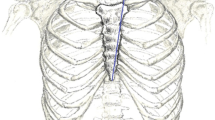Conclusions
-
1.
A successful intubation of the duodenum was accomplished in a two-hour period with any one of four tubes used, in about 90% of the attempts.
-
2.
A lead weighted tip appears to hasten entrance into the duodenum. This, however, has not been determined beyond doubt.
-
3.
Increasing the weight of the tip from 69 grains (Twiss Tube) to 150 grains (Moses Einhorn Tube 1938) does not appear to accelerate its passage, or increase the percentage of successes.
Note: I am grateful to Elsa Nussbaumer, R.N., for her technical assistance.
Similar content being viewed by others
References
Hammeter, J. C.:Johns Hopkins Hosp. Bull., 7:79, April, 1896.
Kuhn, F.: Sondierungen am Magen, Pylorus and Duodenum des Menschen.Archiv. f. Verdauungskr., p. 19, 1898. (Quoted by Max Einhorn in. “The Duodenal Tube,” W. B. Saunders Co., Philadelphia, 1920).
Gross, Maurice: A Duodenal Tube.New York Med. J., 91:77, Jan. 8, 1910.
Einhorn, Max: A Practical Method of Obtaining Duodenal Contents in Man.Medical Record, 77:98, Jan. 15, 1910.
Einhorn, Max: A New Method of Estimating the Permeability of the Pylorus and an Attempt at Testing the Pancreatic Function Directly.New York Med. J., 87:1179, June 20, 1908.
Einhorn, Max: A New Method of Catheterizing the Pylorus and Duodenum.Medical Record, 76:595, Oct. 9. 1909. 7. Palefsky, I. O. : The Examination of the Gastro-duodenal Tract.Interstate Med. J., p. 977, 1914. (Quoted from “The Duodenal Tube,” by Max Einhorn).
Rehfuss, M. E.: A New Method of Gastric Testing, with a Description of a Method for the Fractional Testing of the Gastric Juice.Am. J. Med. Sciences, 147:848, June, 1914.
Lyon, B. B. Vincent: A New Metal Tip Possessing Obvious Advantages for Use in Gastric or Duodenal Tubes.J. A. M. A., 74:276, Jan., 1920.
Einhorn, Moses: New Bucketless Lead Weighted Gastro-duodenal Tube with a Review of the American Contribution to the Development of These Tubes.Am. J. Dig. Dis., 5:77, April, 1938.
Jutte, M. E. : Transduodenal Lavage.New York Med. J., p. 542, March 16, 1912.
Levin, A. J.: A New Gastro-duodenal Catheter.J. A. M. A., 76:1007, April, 1921.
Twiss, J. R.: A New Type of Duodenal Tube Tip.Am. J. Med. Sciences. 185:109, Jan.. 1933.
Lyon, B. B. Vincent: Non-surgical Drainage of Gall Tract. Lea & Febiger, Philadelphia, 1923.
Author information
Authors and Affiliations
Additional information
From the Department of Medicine (Gastro-Enterology) of the New York Hospital and Cornell Medical College.
Rights and permissions
About this article
Cite this article
Lake, M. The influence of the weight of the duodenal tube tip on its entrance time. American Journal of Digestive Diseases 7, 136–138 (1940). https://doi.org/10.1007/BF02997183
Received:
Issue Date:
DOI: https://doi.org/10.1007/BF02997183




